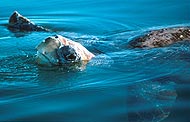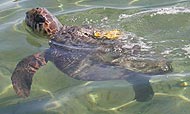
Research Projects – Green and Loggerhead Turtles


An AVED is attached to a green turtle
Green and Loggerhead Turtles
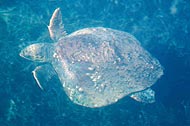
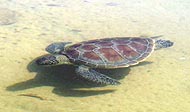
Green and loggerhead turtles are the most common sea turtles in Shark Bay, although leatherback and hawksbill turtles have been cited occasionally (see our turtle species fact sheet for more information on these species). We started recording the presence of sea turtles on our dolphin and dugong transects in 1997, but our sea turtle research began in earnest in 1999 with the first captures and deployments of animal-borne video and environmental data collection (AVED) systems. SBERP research on marine turtles has focused on understanding the foraging ecology of both species and the risk that each species faces from tiger sharks, the influence of food distribution and tiger shark predation risk on turtle habitat use decisions, and influences of water temperature and predation on turtle diving behavior (see our Diving studies page for more on this aspect of the research) - especially the distribution of their food and risk from tiger sharks. In the course of these studies we have also taken the opportunity to investigate the dynamics of turtle populations in a system free from large human impacts and have undertaken studies of long-term movements of loggerhead turtles.
Studying sea turtles in Shark Bay

a green turtle
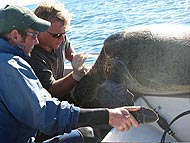
determine a turtle's diet
Like our studies of other air-breathers in Shark Bay, we investigate habitat use patterns of turtles using transect surveys. We have been collecting data on turtle abundance within both shallow and deep sampling zones since 1998 and as of the end of 2008 we had made more than 1,500 passes through these zones. Because turtles can stay submerged for so long (60 min or more) we have to correct our counts for the amount of time turtles spend underwater and their pattern of surfacing in each habitat and season. We can then compare the seasonal and habitat differences in turtle abundance to data on prey distributions (seagrass and jellyfish surveys for green turtles and benthic invertebrate surveys for loggerhead turtles) and tiger shark habitat use and abundance to investigate the relative importance of prey and predators in shaping their habitat use choices.
For our detailed turtle studies, we have to catch them. This is accomplished by diving off our research vessel and swimming them up to the surface (click here to see a video). Sometimes captures involve a chase. For the first couple of years we measured the swimming speed of the turtle and the number of sharp turns that it made to determine species differences in escape ability. Once the turtle is on the boat we measure the length and width of the carapace, affix an identification tag to the front flippers, and check the turtle for injuries that may have been caused by tiger sharks. We also collect tissue samples for genetic analysis and food web studies using stable isotopes. Finally, before letting the turtle go, we determine its body condition and, in order to test our measures of body condition, sometimes weigh it.
By measuring the ratios of stable carbon and nitrogen isotopes, we can determine the relative trophic level of marine turtles in the bay and get an idea of the relative contributions of jellyfish, seagrasses, and algae in the diets of green turtles. We use blood and small tissue samples collected during captures to conduct these analyses.
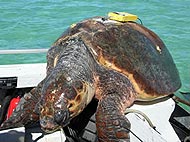
package) about to be released
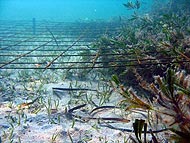
determine the effects of turtle and
dugong grazing on seagrass
communities
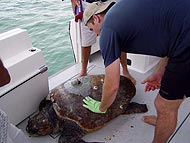
turtle. The glue will be covered with anti-
fouling paint to prevent encrusting
organisms from overgrowing the
transmitter
To get detailed data on turtle diving, foraging, and social behavior we began deploying AVEDs in 1999. We started by deploying National Geographic's Crittercam on both green and loggerhead turtles (1999-2004) and now we are using several types of custom-built systems that have a video camera (some using GoPro cameras) and also have a Wildlife Computers MK-10 time depth recorder that can also record the GPS position of the turtle at every surfacing. This lets us determine exactly where we see particular behaviors like cleaning, foraging, and social interactions.
AVEDS are attached using a suction cup (for most green turtles) or glued to the shell using a cool-setting epoxy (for loggerheads and some greens) that will slough off in about a week. The cameras are deployed for 6-72hrs and then a computer, or back-up dissolving magnesium link, releases the camera from the turtle using an automatic release system. The system then floats to the surface where we can track it down using a VHF tracking system to retrieve it. Once data are downloaded the system can be deployed again. Old systems recorded up to six hours of video while new systems record nine hours and are much smaller than the one pictured at left. So far, we have attached AVED to more than 130 turtles and our studies are continuing.
To gain long-term insights into turtle diving behavior that are not possible with AVEDs, we began deploying time-depth recorders (TDRs) in 2005. The small packages that we built include the TDR, an acoustic transmitter (works through water up to 1000m), and a VHF transmitter (works through air up to 20+km) set into syntactic foam. The combination of VHF and acoustic transmitters let us find the turtle during the 5-7 day deployments so we can see which habitats it is in. The VHF transmitter lets us find and recover the package when the magnesium link that holds it to a small patch of mesh glued to the turtle's carapace dissolves.
In order to determine how green turtle and dugong foraging helps to shape seagrass communities, we have constructed 20 1.6 m x 2.6 m exclosures (and designated paired control plots) that prevent turtles and dugongs from grazing. We can then measure the species and biomass of seagrass inside the exclosures and controls as well as the chemical composition of each species to determine how turtle and dugong grazing impacts the seagrass community itself. Of course, if tiger sharks influence when, how, and where turtles and dugongs graze they could be indirectly influencing seagrasses. See our Indirect effects of tiger sharks page for more information on our exclosure experiment.
Our final ongoing study with sea turtles is to determine the long-term movements of loggerhead turtles, especially males. In 2005, we teamed up with the Department of Environment and Conservation (DEC) and the Yadgalah Aboriginal Corporation to attach satellite transmitters to three female and two male loggerhead turtles. These tags gave us daily positions (with an accuracy of 100s of meters) for the turtles for up to a year. Because there is virtually nothing known about the movements and behaviors of male turtles on the foraging grounds and between the foraging grounds and their breeding grounds, we decided to continue this study and we have recently attached nine more satellite transmitters to male turtles. Transmitters are attached to the carapace with epoxy that will not slough off (unlike the epoxy used to attach TDRs and AVEDs) and then painted with anti-fouling paint. Whenever the turtle is at the surface and there is a satellite overhead we receive an email letting us know where the turtle was.
Shark Bay Turtle Populations

Shark Bay breed on Dirk Hartog Island
in the bay's Western Gulf
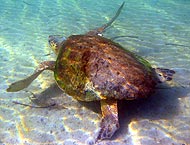
in its right front flipper
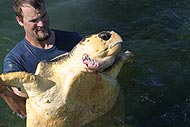
from a tiger shark attack
Overall, the turtle populations in Shark Bay are in good shape - the population is large and many of the turtles are quite large compared to areas where humans have hunted turtles. Also, a major disease of green turtles - fibropappiloma - that causes tumorous growths is virtually absent in Shark Bay. In many more developed areas most green turtles have tumors.
Our study area is mainly a foraging ground - one of the most important on the Western Australian coast. Although we do see mating occasionally (at least in loggerhead turtles), green turtles travel to northern Western Australia to breed while loggerheads swim to the Western Gulf of Shark Bay to nest on Dirk Hartog Island or travel further north like the green turtles. Interestingly, the sex ratio of loggerheads is approximately 1:1 but there are far more female green turtles than males in our study area. Go to our turtle species fact sheet to learn how we tell males and females apart.
Most turtles spend a lot of time in Shark Bay and we have recaptured almost half of the loggerhead turtles we have tagged. Most of these recaptures are very close to the spot they were originally tagged, but some do move up to 30 km along a coastal strip of sandy habitat where there is a lot of prey for loggerheads. There are far fewer recaptures of green turtles, but based on where our TDR packages have been retrieved this is probably because the green turtle population is larger.
Both green and loggerhead turtles are at risk from tiger sharks and have been found in shark stomachs. Loggerhead turtles - especially males - are probably at greater risk. Less than 5% of green turtles have injuries from shark attacks. On the other hand, about 20% of female loggerheads and 50% of male loggerheads are missing flippers or chunks from their shells as a result of shark attacks. Many of these wounds are fresh indicating that turtles are being attacked in our study area. Differences in attack rates between greens and loggerheads may be partially explained by differences in speed and maneuverability. Green turtles are much faster and are more maneuverable. However, differences in diving behavior (loggerheads lull longer at the surface) may also contribute.
Turtle Foraging and Cleaning
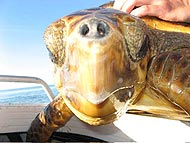
crushing invertebrates

herbivores? No!
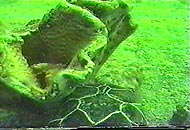
a sponge
Loggerhead turtles are widely known as generalist predators of invertebrates- they aren't too picky - they will eat crabs, large snails, and bivalves (clams, scallops, oysters, mussels, etc) to name a few. Our video and isotopic data confirm that loggerheads in Shark Bay are behaving similarly to their relatives in other parts of the world. Shark Bay loggerheads will rest in deep water but often move onto shallow sandflats to forage. They use their crushing beak to break through the hard shells of bivalves, like oysters. For partially buried prey, like pen shells, they use their front flippers to dig them out. When they are foraging on the flats, loggerheads often are followed by schools of small fish waiting to pick up the scraps from the turtle's feeding (they are messy eaters).
Green turtles were more surprising. Greens are widely thought to specialize largely on eating seagrasses or macroalgae depending on their availability. Our videos, however, showed turtles eating relatively little seagrass and instead eating dozens of comb jellies (ctenophores) and jellyfish. Because seagrasses and plankton (jellies) have very different carbon signatures and jellies and algaes have different nitrogen signatures we have been able to investigate the diets of more than 60 turtles. We were surprised to find that these individuals differed greatly in the types of food they were eating - some appear to be seagrass specialists, others probably eat mainly jellies or mainly macroalgae, while others still mix their diets and may even eat sponges. We are now trying to determine what drives such diversity in feeding behaviors in the green turtles of Shark Bay.
Videos also showed us another unexpected behavior. Green turtles use sponges and rocks as rubbing posts, probably to clean barnacles and algae from their bodies and shell. Sometimes the turtles chase one another away from desirable rubbing locations. Loggerhead turtles have never been taped rubbing, which may help explain why most green turtles have clean shells and heads and most loggerheads are covered in barnacles and algae.
Effects of prey availability and tiger shark predation risk on turtle habitat use
We were surprised to find that green turtles did not show a shift in habitat use in response to increased risk of predation from tiger sharks at the level of the population. However, this does not mean that green turtles are ignoring tiger sharks. Instead, green turtles choose their microhabitats based on their body condition! Turtles close to starvation take advantage of the better quality seagrass in the middle of banks, but at a heightened risk of being killed by sharks. Turtles in good condition don't risk it - they tend to be found right at the border of deep water where the food is of poorer quality, but it is easier to escape.
The smallest green turtles (45cm and smaller) that have recently settled from oceanic habitats to coastal waters appear to be the most responsive to predation risk and are rarely found on the dangerous offshore banks. Instead they are found most often in very shallow waters close to shore or in mangrove creeks.
Check back soon for brand new videos about our turtle research including videos from the backs of turtles!
Sea Turtle Publications
- Heithaus, M. R. Predators, prey, and ecological roles of sea turtles. 2013. In: Wyneken, J. and J. A. Musick (eds) Biology of Sea Turtles, Volume III. CRC Press.
- Olson, E. L., A. K. Salomon, A. J. Wirsing and M. R. Heithaus. 2012. Large-scale movement patterns of male loggerhead sea turtles (Caretta caretta) in Shark Bay, Australia. Marine and Freshwater Research 63: 1108-1116.
- Burkholder, D. A., M. R. Heithaus, and J. A. Fourqurean. 2012. Feeding preferences of herbivores in a relatively pristine subtropical seagrass ecosystem. Marine and Freshwater Research 63: 1051-1058.
- Belicka, L. L., D. Burkholder, J. W. Fourqurean, M.R. Heithaus, S. A. Macko and R. Jaffé. 2012. Stable isotope and fatty acid biomarkers of seagrass, epiphytic, and algal organic matter to consumers in a nearly pristine seagrass ecosystem. Marine and Freshwater Research 63: 1085-1097.
- Thomson, J. A., M. R. Heithaus, and L. M. Dill. 2011. Informing the interpretation of dive profiles using animal-borne video: a marine turtle case study. Journal of Experimental Marine Biology and Ecology 410: 12-20.
- Burkholder, D., M. R. Heithaus, J. Thomson, and J. A Fourqurean. 2011. Diversity in trophic interactions of green sea turtles (Chelonia mydas) on a relatively pristine coastal foraging ground. Marine Ecology Progress Series 439:277-293.
- Thomson, J. A., D. A. Burkholder, A. B. Cooper, M. R. Heithaus, and L. M. Dill. 2012. Heterogeneous patterns of availability for detection during visual surveys: spatiotemporal variation in sea turtle dive-surfacing behaviour on a feeding ground. Methods in Ecology and Evolution 3: 378-387.
- Thomson, J. A., D. Burkholder, M. R. Heithaus, and L. M. Dill. 2009. Validation of a rapid visual assesment technique for categorizing the body condition of green sea turtles. Copeia 2009: 251-255.
- Wirsing, A. J., M. R. Heithaus, and R. Abernathy. 2008. Differences in escape abilities do not explain sex differences in predator-inflicted injury rates of loggerhead turtles. Journal of Herpetology 1: 411-413.
- Heithaus, M. R., A. J. Wirsing, J. Thomson, and D. Burkholder. 2008. A reveiew of lethal and non-lethal effects of predators on adult marine turtles. Journal of Experimental Marine Biology and Ecology 356: 43-51.
- Heithaus, M. R., A. Fird, A. J. Wirsing, L. M. Dill, J. Fourqurean, D. Burkholder, J. Thomson, and L. Bejder. 2007. State-dependent risk-taking by green sea turtles mediates top-down effects of tiger shark intimidation in a marine ecosystem. Journal of Animal Ecology 76: 837-844.
- Heithaus, M. R., A. Frid, A. Wirsing, L. Bejder, and L. M. Dill. 2005. The biology of green and loggerhead turtles under risk from tiger sharks at a foraging ground. Marine Ecology Progress Series 288: 285-294.
- Heithaus, M. R. J. M. McLash, A. Frid, L. M. Dill, and G. J. Marshall. 2002. Novel insights into the behavior of sea turtles from animal-borne cameras. Journal of the Marine Biological Association UK: 1049-1050.
- Heithaus, M. R., A. Frid, and L. M. Dill . 2002. Shark-inflicted injury frequencies, escape ability, and habitat use of green and loggerhead turtles. Marine Biology 140: 229-236.
All photographs copyrighted; Images may be used for educational purposes. For use in other forms contact Mike Heithaus
